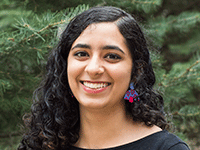The NSF Graduate Research Fellowship Program (GRFP) has selected two Harvard MCO graduate students — Hasreet Gill [G2] of the Tabin Lab and Roya Huang [G2] of the Ramanathan Lab — and a biophysics graduate student — Olivia Meyerson [G2] of the Hoekstra Lab — for its fellowship class of 2019.

Roya Huang
“I’m honored to be part of a program that values basic science and science outreach,” Huang says. “I have been incredibly fortunate to have received mentorship from a diverse group of scientists in my time thus far, and I’m excited to contribute this forward to younger students.”
The GRFP is the oldest and one of the largest graduate student fellowship programs in the country. Since its inception in 1952, over half a million students have applied to the program, and over 50,000 have received fellowship funding. GRFP awardees receive an annual stipend of $34,000, along with $12,000 paid to the institution to cover the cost of tuition and fees.

Hasreet Gill
“It feels good to be recognized,” Gill says of receiving her award. “I think my application was a good representation of my authentic self and the ideas I’m most passionate about…Having all of that validated by a group of anonymous strangers is weirdly satisfying.”

Olivia Meyerson
Meyerson, who is currently studying the evolution of burrowing behavior in mice, says that she is also deeply honored to receive GFRP funding. “This is an incredible opportunity to conduct experiments that will further my quest to find the genetic basis of burrowing behavior,” she says.
The funding will allow her to conduct experiments where she crossbreeds two populations of mice that exhibit distinctly different burrowing behaviors. “I use two populations of deer mice with heritable differences in burrowing behaviors to identify specific genes that affect burrowing,” Meyerson explains. “In discovering genes that underlie differences in burrowing behavior, I hope to deepen our understanding of how genetic changes can alter the brain to yield adaptive behaviors.”
“I would like to thank my advisor, Hopi Hoekstra, and my entire lab for their support and encouragement. I feel really fortunate to be in such a wonderful lab,” Meyerson adds. “I would also like to thank my former advisors, Dr. Matt Carter at Williams College and Dr. Alex Pollen at UCSF, for their amazing mentorship and continued advice.
Huang’s award will enable her to use quantitative techniques to study stem cells in the Ramanathan Lab. “I study how cells of the embryo make decisions,” she explains. “How do these cells “commit” to a particular developmental trajectory (e.g. neurons or skin)? How do they interact with their larger environments? How are signals and geometries of the organism detected by individual cells, and what do they do in response?”
“The field of development lets me study this in the context of a large, rapidly changing organism,” she adds. “It’s exhilarating!”
Gill will also use her award to further her studies of developmental biology. In particular, she’s interested in how sections of the embryonic gut tube morph into distinct organs, such as the esophagus, the colon, and the small intestine.
Scientists know about many of the chemical signals that drive cells in the gut tube to differentiate, but much less is known about how physical forces like pressure and stretching affect the process. “We know how these compartments get their identities, but we don’t know how they’re actually sculpted to make the forms tied to their unique functions,” Gill says. “I’m studying this physical process and asking how mechanical forces help shape different regions along the gut.”
“A lot of the work I’m doing now involves dissecting out tissue from the embryo and doing mechanical tests, but it would be amazing to better understand in vivo tissue mechanics, which may require resources I can access as a result of the fellowship,” she adds. “I plan to do live imaging of cells and extracellular matrix with dissected guts in culture to understand how mechanical cues affect cell behaviors, and if I have the opportunity to explore more sophisticated imaging techniques, this fellowship would help with necessary equipment, travel, or courses.”
Congratulations to these three promising scientists on their NSF Graduate Research Fellowships!
by Diana Crow



